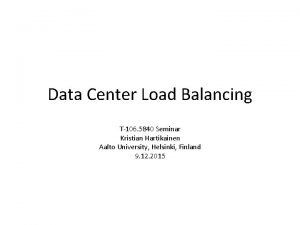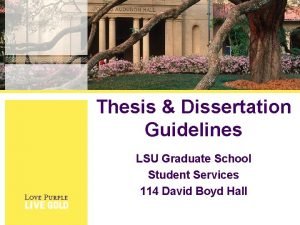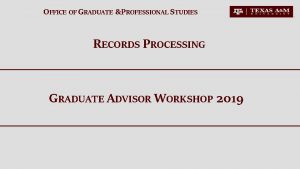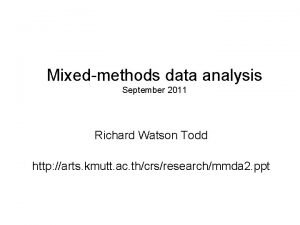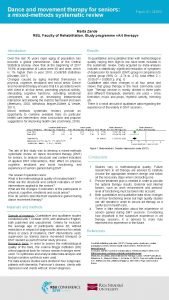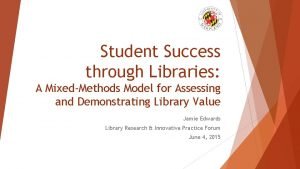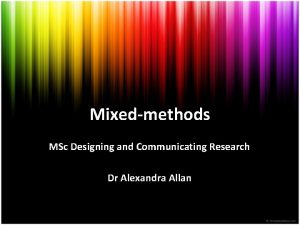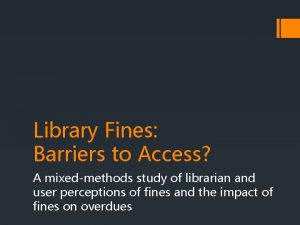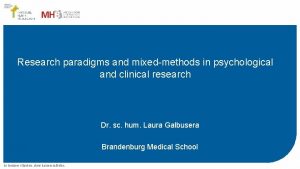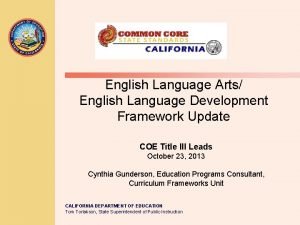Mixedmethods data analysis Graduate Seminar in English Language




















- Slides: 20

Mixed-methods data analysis Graduate Seminar in English Language Studies Suranaree, March 2011 Richard Watson Todd KMUTT http: //arts. kmutt. ac. th/crs/research/mmda. ppt

Overview n n n Pure quantitative research Pure qualitative research Mixed-methods research q n Collecting both QUANT and QUAL data using different instruments Mixed-methods data analysis q q Usually only QUAL data collected Data is treated both quantitatively and qualitatively

Quantitative or qualitative? n n QUANT – QUAL distinction in applied linguistics research QUANT: data is numbers; uses statistics q n Experimental research; surveys QUAL: data is words; uses thematic or narrative interpretation q Conversation analysis; ethnography

Mixed-methods research n n “A mixed methods study involves the collection or analysis of both quantitative and qualitative data in a single study with some attempts to integrate the two approaches at one or more stages of the research process” (Dörnyei, 2007) Purposes: q q Achieve a fuller understanding Triangulate findings

Examples of mixed-methods research n Poor example q q n Research into attitudes: survey a large number and interview a predetermined small number of subjects Purpose: unclear Similar, slightly better example q q Research into attitudes: survey a large number of subjects, then, selecting based on questionnaire responses, interview a small number Purpose: follow-up on interesting results

Examples of mixed-methods research n An example of the opposite q q n Interview a small number to gain insights to design a questionnaire, then survey a large number Purpose: informing instrument design Another similar example q q Research into beliefs: interview 4 teachers but survey 80 students Purpose: accounting for practicality in using instruments

Examples of mixed-methods research n An example focusing on triangulation q q q Research into strategies: comparing results from different instruments Much strategy research involves the use of SILL asks respondents to identify how often they use a particular strategy Strategy use is context-dependent Research question: Will recent context of learning change responses to SILL?

Examples of mixed-methods research n Method q q q Single subject Time 1: read academic articles Time 2: read short stories for pleasure Responded to SILL twice Interviewed 4 times (background interview, after SILL responses, summary interview)

Examples of mixed-methods research n SILL responses q n Interview responses q n Showed major differences between 2 times e. g. “If I guess the meaning of a word, later I will check whether my guess is correct by using a dictionary. ” rated Always at Time 1; Never at Time 2 Showed that recent learning contexts influenced different ratings Triangulation to confirm results or triangulation to provide different perspectives

Mixed-methods data analysis n “The most common perception of mixed methods research is that it is a modular process in which qualitative and quantitative components are carried out either concurrently or sequentially. Although this perception is by and large true, it also suggests that the analysis of the data should proceed independently for the QUANT and QUAL phases and mixing should occur only at the final interpretation stage. This conclusion is only partially true … we can also start integrating the data at the analysis stage, resulting in what can be called mixed methods data analysis” § Dörnyei (2007)

Mixed-methods data analysis (MMDA) n From Dörnyei, MMDA means q Quantitising qualitative data q Qualitising quantitative data

Quantitising qualitative data n Quantitising is often done unconsciously q q n n n Conducting a keyword analysis Use of IELTS scores in research Quantitising helps a qualitative analysis by allowing a reliability check Quantitising can be used to count and compare frequency of themes Quantitising allows further statistical analysis of data, but information is always lost when converting QUAL to QUANT

Qualitising quantitative data n n Not common Narrative profile formation q Using quantitatively obtained questionnaire data in a qualitative description of a subject

More complex MMDA n Nature of QUANT data q q q n Concise Allows further analysis (inferential statistics) Provides summary information Nature of QUAL data q q q Detailed and informative Allows insight into cases Provides in-depth information

More complex MMDA n What purposes can mixing QUANT and QUAL data analysis serve? q q Illustration for insight Concise summary to give overview Preliminary overview to inform analysis Providing a more well-rounded and more persuasive analysis

MMDA: Illustration for insight n n n In many QUANT studies, it is easy to get lost in the numbers and forget what they mean If the numbers are derived from QUAL data, it is useful to give a QUAL example to concretise the QUANT findings In Case 1, the original data is QUAL; this is quantitised for analysis; a QUAL example is given to concretise the data and to show the quantitative analyses was applied

MMDA: Summarising for an overview n n n In some QUAL research (primarily involving categorisation or thematisation), the lengthy, detailed data make it difficult to see the overall pattern It can be useful to provide a QUANT summary as an overview In Case 2, the data is QUAL and analysed in a QUAL way, but the overall pattern of results is presented as QUANT

MMDA: Preliminary overview to inform analysis n n In QUAL studies with large amounts of data, it is difficult for the researcher to ensure that all relevant issues have been identified It is also difficult to see underlying patterns that can be drowned in the sheer quantity of data It is useful to conduct a preliminary QUANT analysis to ensure all issues and underlying patterns are identified In Case 3, QUAL data is treated qualitatively to find keywords which then inform a QUAL thematic analysis

MMDA: Providing a more wellrounded and more persuasive analysis n In QUAL studies with large amounts of data, n n n restricting analysis to either QUANT or QUAL cannot provide a full picture of the data QUAL provides detailed description of the data QUANT provides generalisations of patterns to the whole data set In Case 4, QUAL and QUANT analyses are used together to produce a fuller description of the data

Uses of MMDA n Use n Pattern n Illustration for insight Summarise for overview Inform analysis Provide full picture n QUANT → QUAL → QUANT n n n QUANT → QUAL Mix of QUANT and QUAL
 How to presentation in english
How to presentation in english English seminar presentation
English seminar presentation Levels of language knowledge
Levels of language knowledge Indexing in data warehouse
Indexing in data warehouse Data center seminar
Data center seminar Data quality is always a concern with secondary data
Data quality is always a concern with secondary data Data collection procedure and data analysis
Data collection procedure and data analysis Data preparation and basic data analysis
Data preparation and basic data analysis Data acquisition and data analysis
Data acquisition and data analysis Phi beta sigma logo
Phi beta sigma logo Government statistical service graduate scheme
Government statistical service graduate scheme Uhmt 1012
Uhmt 1012 Graduate attributes binus
Graduate attributes binus Graduate success attributes magazine
Graduate success attributes magazine Lsu thesis and dissertation library
Lsu thesis and dissertation library Graduate college jamshedpur
Graduate college jamshedpur Aldi graduate scheme review
Aldi graduate scheme review 15-780 graduate artificial intelligence
15-780 graduate artificial intelligence School of graduate studies upm
School of graduate studies upm Pfizer uk graduate scheme
Pfizer uk graduate scheme Ogaps degree plan
Ogaps degree plan




